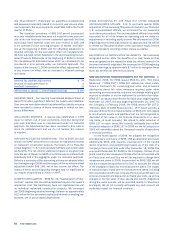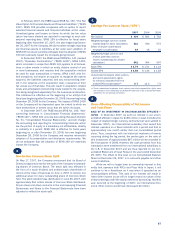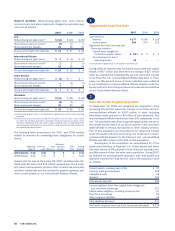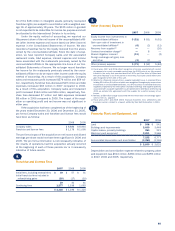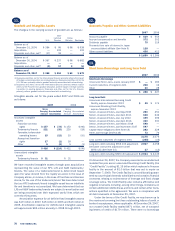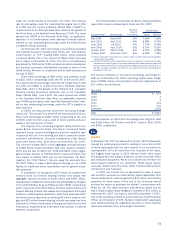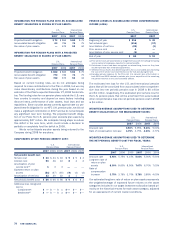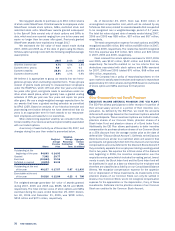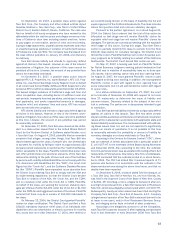Pizza Hut 2007 Annual Report Download - page 72
Download and view the complete annual report
Please find page 72 of the 2007 Pizza Hut annual report below. You can navigate through the pages in the report by either clicking on the pages listed below, or by using the keyword search tool below to find specific information within the annual report.
76 YUM! BRANDS, INC.
We may grant awards to purchase up to 28.0 million shares
of stock under SharePower. Potential awards to employees under
SharePower include stock options, SARs, restricted stock and
restricted stock units. SharePower awards granted subsequent
to the Spin-off Date consist only of stock options and SARs to
date, which vest over a period ranging from one to four years and
expire no longer than ten years after grant. Previously granted
SharePower awards have expirations through 2017.
We estimated the fair value of each award made during
2007, 2006 and 2005 as of the date of grant using the Black-
Scholes option-pricing model with the following weighted-average
assumptions:
2007 2006 2005
Risk-free interest rate 4.7% 4.5% 3.8%
Expected term (years) 6.0 6.0 6.0
Expected volatility 28.8% 31.0% 36.6%
Expected dividend yield 2.0% 1.0% 0.9%
We believe it is appropriate to group our awards into two homo-
geneous groups when estimating expected term. These groups
consist of grants made primarily to restaurant-level employees
under the RGM Plan, which cliff vest after four years and expire
ten years after grant, and grants made to executives under our
other stock award plans, which typically have a graded vesting
schedule of 25% per year over four years and expire ten years
after grant. We use a single-weighted average expected term for
our awards that have a graded vesting schedule as permitted
by SFAS 123R. Based on analysis of our historical exercise and
post-vesting termination behavior we have determined that six
years is an appropriate term for both awards to our restaurant-
level employees and awards to our executives.
When determining expected volatility, we consider both his-
torical volatility of our stock as well as implied volatility associated
with our traded options.
A summary of award activity as of December 29, 2007, and
changes during the year then ended is presented below.
Weighted-
Weighted- Average Aggregate
Average Remaining Intrinsic
Exercise Contractual Value
Shares Price Term (in millions)
Outstanding at the
beginning of the year 54,603 $ 14.93
Granted 7,302 29.77
Exercised (10,564) 11.16
Forfeited or expired (2,204) 23.35
Outstanding at the end
of the year 49,137 $ 17.57 5.67 $ 1,030
Exercisable at the end
of the year 30,516 $ 12.80 4.23 $ 786
The weighted-average grant-date fair value of awards granted
during 2007, 2006 and 2005 was $8.85, $8.52 and $8.89,
respectively. The total intrinsic value of stock options and SARs
exercised during the years ended December 29, 2007, Decem-
ber 30, 2006 and December 31, 2005, was $238 million,
$215 million and $271 million, respectively.
As of December 29, 2007, there was $103 million of
unrecognized compensation cost, which will be reduced by any
forfeitures that occur, related to unvested awards that is expected
to be recognized over a weighted-average period of 2.7 years.
The total fair value at grant date of awards vested during 2007,
2006 and 2005 was $58 million, $57 million and $57 million,
respectively.
The total compensation expense for stock options and SARs
recognized was $56 million, $60 million and $58 million in 2007,
2006 and 2005, respectively. The related tax benefit recognized
from this expense was $19 million, $21 million and $20 million
in 2007, 2006 and 2005, respectively.
Cash received from stock options exercises for 2007, 2006
and 2005, was $112 million, $142 million and $148 million,
respectively. Tax benefits realized on our tax returns from tax
deductions associated with stock options and SARs exercised
for 2007, 2006 and 2005 totaled $76 million, $68 million and
$94 million, respectively.
The Company has a policy of repurchasing shares on the
open market to satisfy award exercises and expects to repurchase
approximately 10 million shares during 2008 based on estimates
of stock option and SARs exercises for that period.
18.
Other Compensation and Benefit Programs
EXECUTIVE INCOME DEFERRAL PROGRAM (THE “EID PLAN”)
The EID Plan allows participants to defer receipt of a portion of
their annual salary and all or a portion of their incentive com-
pensation. As defined by the EID Plan, we credit the amounts
deferred with earnings based on the investment options selected
by the participants. These investment options are limited to cash,
phantom shares of our Common Stock, phantom shares of a
Stock Index Fund and phantom shares of a Bond Index Fund.
Additionally, the EID Plan allows participants to defer incentive
compensation to purchase phantom shares of our Common Stock
at a 25% discount from the average market price at the date of
deferral (the “Discount Stock Account”). Deferrals to the Discount
Stock Account are similar to a restricted stock unit award in that
participants will generally forfeit both the discount and incentive
compensation amounts deferred to the Discount Stock Account if
they voluntarily separate from employment during a vesting period
that is two years. We expense the intrinsic value of the discount
and, beginning in 2006, the incentive compensation over the
requisite service period which includes the vesting period. Invest-
ments in cash, the Stock Index fund and the Bond Index fund will
be distributed in cash at a date as elected by the employee and
therefore are classified as a liability on our Consolidated Balance
Sheets. We recognize compensation expense for the apprecia-
tion or depreciation of these investments. As investments in the
phantom shares of our Common Stock can only be settled in
shares of our Common Stock, we do not recognize compensation
expense for the appreciation or the depreciation, if any, of these
investments. Deferrals into the phantom shares of our Common
Stock are credited to the Common Stock Account.


